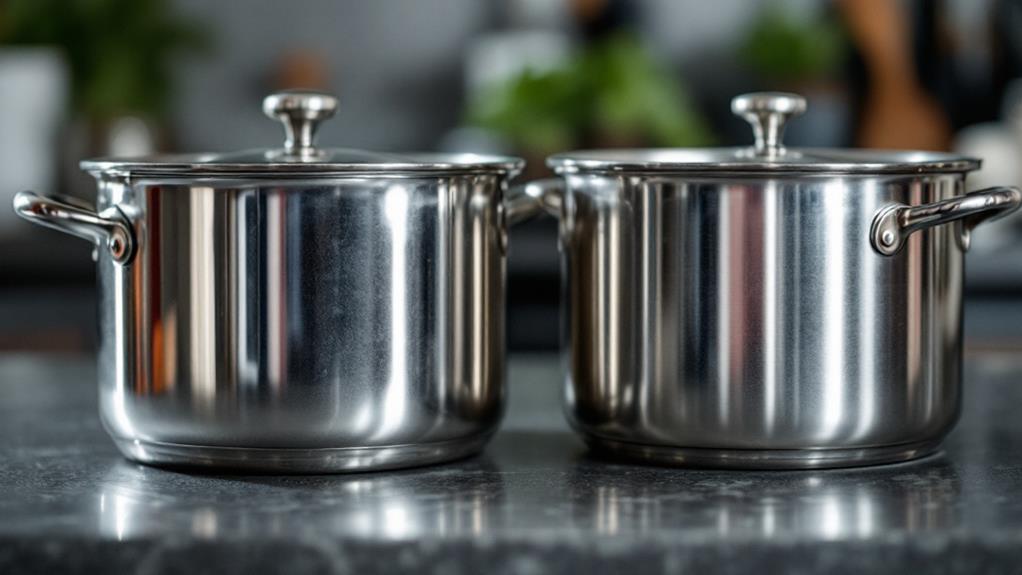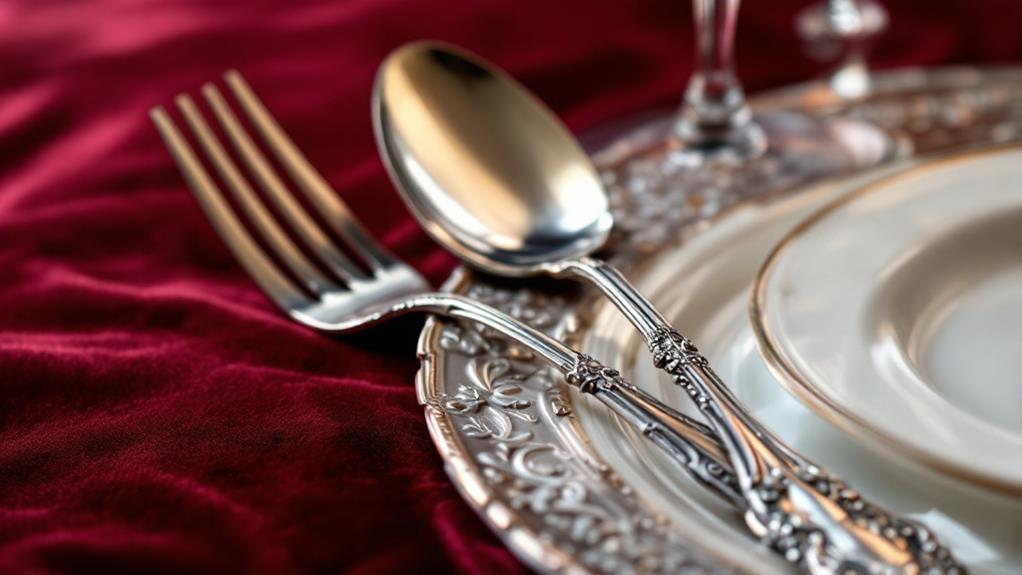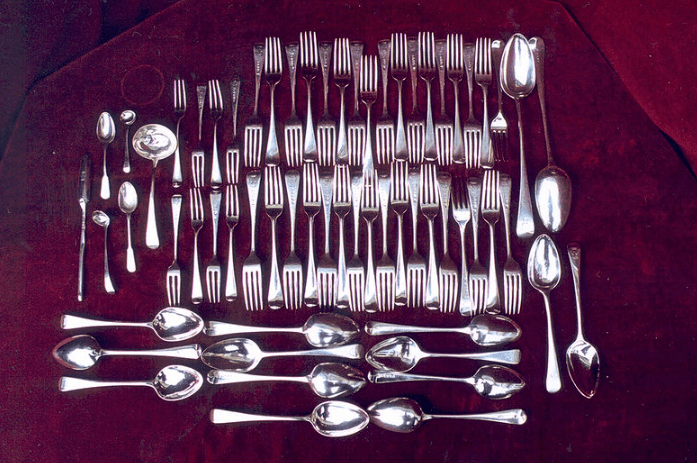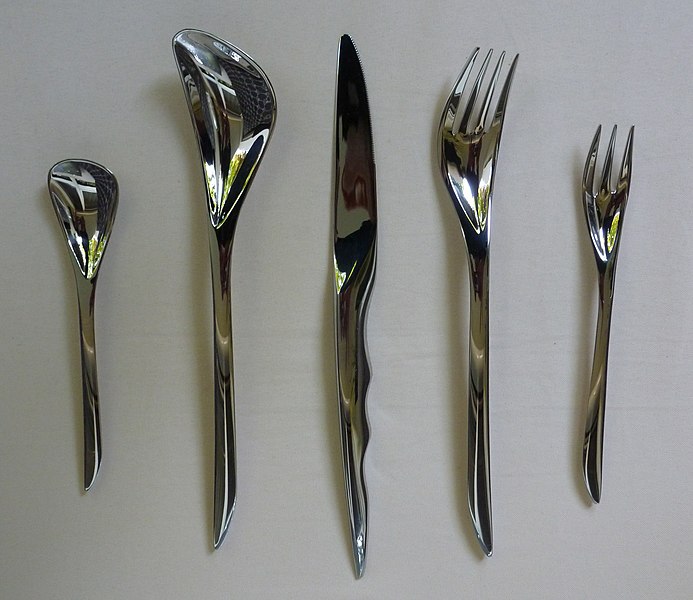What Is the Difference Between Utensils and Cutlery?
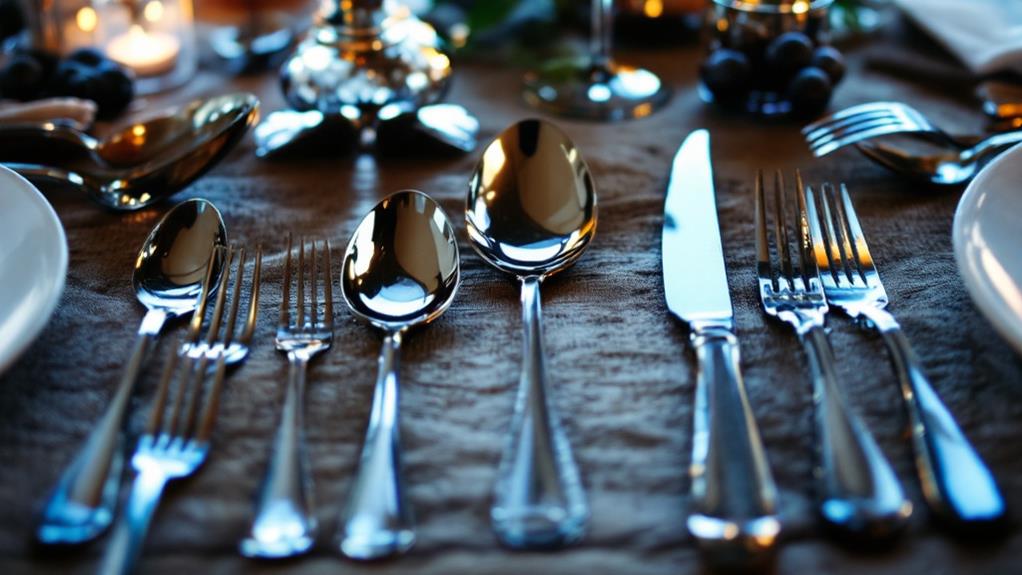
Utensils and cutlery are often used interchangeably, but they're not exactly the same. Utensils refer to a broader category of tools used for food preparation and eating, including items like spoons, forks, knives, ladles, and chopsticks. Cutlery, on the other hand, specifically refers to cutting implements used for eating and preparing food, typically knives, forks, and spoons in Western table settings. While all cutlery items are utensils, not all utensils are cutlery. The distinction becomes clearer when you consider kitchen tools like spatulas or measuring cups, which are utensils but not cutlery. Exploring their rich history and cultural variations reveals fascinating perspectives into dining customs worldwide.
Defining Utensils and Cutlery
Anyone who's ever set a table or prepared a meal has likely encountered both utensils and cutlery. While these terms are often used interchangeably, they actually have distinct meanings and origins.
Utensils refer to a broad category of tools used for various purposes, particularly in food preparation and consumption. This term encompasses a wide range of dining accessories, including spoons, forks, knives, serving spoons, ladles, and even chopsticks. You'll find utensils in kitchens and table settings worldwide, with designs varying based on cultural traditions and specific food requirements.
Cutlery, on the other hand, has a narrower definition. It specifically refers to cutting implements used for eating and preparing food. The term is most commonly associated with knives, forks, and spoons used in Western table settings. Cutlery is often made of metal, such as stainless steel or silver, and is considered an essential part of formal dining etiquette.
Understanding the difference between these terms can help you communicate more precisely about dining accessories and table settings. While all cutlery items are utensils, not all utensils are cutlery. This distinction becomes particularly important when discussing specific types of dining tools or planning formal events.
Historical Origins
Throughout history, the evolution of utensils and cutlery has mirrored the development of human civilization. The ancient origins of these tools date back to prehistoric times when humans first used sharpened stones and sticks to eat. As societies advanced, so did their eating implements.
In ancient Egypt, you'd find spoons made of wood, stone, and ivory, while the Greeks and Romans introduced more refined utensils, including early forms of forks. The Middle Ages saw the widespread use of knives as both eating tools and personal weapons. It wasn't until the Renaissance that the fork gained popularity in Europe, starting in Italy and spreading northward.
The historical development of cutlery took a significant turn during the Industrial Revolution. Mass production techniques allowed for the creation of more affordable and standardized sets of knives, forks, and spoons. This democratization of cutlery led to its widespread adoption across social classes.
Today, you'll find a vast array of specialized utensils and cutlery, each designed for specific culinary purposes. From chopsticks in East Asia to the elaborate place settings of formal Western dining, these tools continue to reflect cultural practices and technological advancements.
Materials and Construction
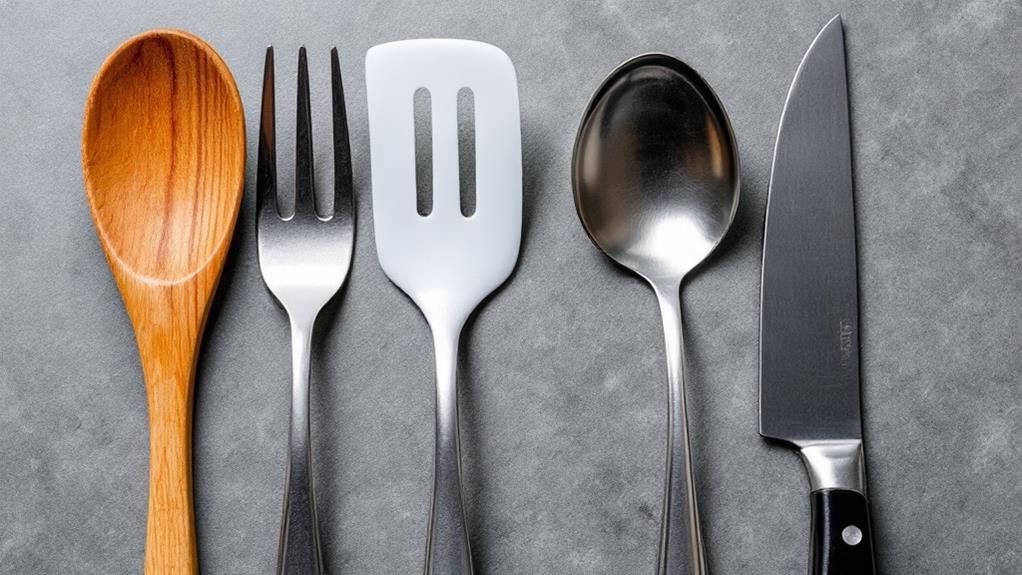
When it comes to materials and construction, utensils and cutlery offer a diverse range of options. You'll find that both categories plunge into similar materials, but their manufacturing techniques can differ markedly.
For utensils, you'll often encounter stainless steel, plastic, wood, and bamboo. Stainless steel utensils are typically made from an alloy composition of iron, chromium, and nickel, offering durability and resistance to corrosion. Plastic utensils are usually injection-molded, while wooden and bamboo options are carved or shaped from natural materials.
Cutlery, on the other hand, tends to focus more on metal alloys. High-carbon stainless steel is a popular choice for its strength and ability to maintain a sharp edge. You'll also find cutlery made from silver, titanium, or even ceramic. The manufacturing techniques for cutlery often involve forging, stamping, or laser cutting, depending on the desired quality and price point.
Both utensils and cutlery can incorporate handles made from various materials, including wood, plastic, or metal. The construction methods for these handles range from simple molding to intricate inlay work, affecting both the aesthetics and functionality of the final product.
Types of Utensils
Utensils come in a wide variety of types, each designed for specific culinary tasks. When you think of dining flatware varieties, you'll likely visualize forks, knives, and spoons. These essential items form the core of most table settings. You'll find salad forks, dinner forks, dessert forks, butter knives, steak knives, soup spoons, and teaspoons among the most common types.
Beyond these basics, you'll encounter specialized utensils like fish knives, oyster forks, grapefruit spoons, and chopsticks. These cater to specific cuisines or dishes, enhancing your dining experience.
In the kitchen, you'll use a broader range of multipurpose kitchen tools. These include spatulas, ladles, tongs, whisks, and serving spoons. You'll also find more specialized items like potato mashers, garlic presses, and pasta servers. Each of these utensils serves a unique purpose in food preparation and cooking.
Don't forget about measuring tools like cups and spoons, which are indispensable for following recipes accurately. You'll also use cutting tools such as peelers, graters, and zesters for various food preparation tasks.
Categories of Cutlery
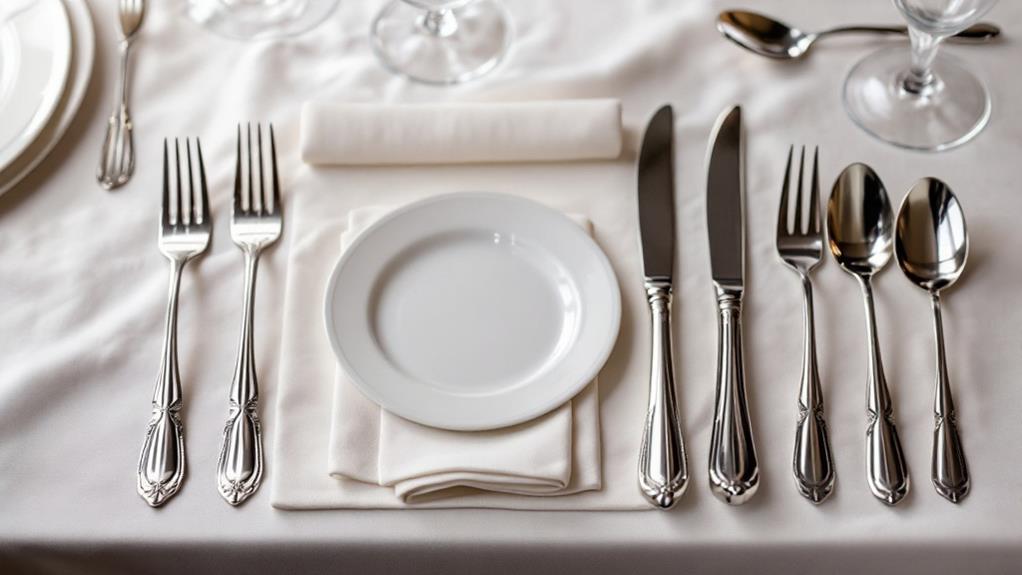
Cutlery, often interchanged with flatware, falls into distinct categories based on function and design. You'll find that the most common categories include dining cutlery, serving cutlery, and kitchen cutlery. Dining cutlery typically consists of forks, knives, and spoons used for eating meals. Serving cutlery includes larger versions of these items, designed for dishing out food from serving bowls or platters. Kitchen cutlery encompasses a wide range of tools used in food preparation, such as chef's knives, paring knives, and kitchen shears.
When exploring cutlery, you'll encounter utensils for specific cuisines and specialized cooking techniques. For example:
- Japanese cuisine features chopsticks and unique items like sushi knives
- Indian cooking utilizes special spoons like the kadai and slotted spoons for curries
- Molecular gastronomy employs unique tools like pipettes and tweezers
Beyond these categories, you'll find specialty cutlery designed for specific foods or dining experiences. This includes seafood forks, steak knives, and grapefruit spoons. As you investigate further into the world of cutlery, you'll discover an array of specialized tools adapted to enhance your culinary experiences and make food preparation more efficient.
Cultural Variations
As you investigate the world of utensils and cutlery, you'll find that cultural variations play a significant role in shaping dining customs and tools. Different regions around the globe have developed unique approaches to eating, reflecting their history, traditions, and available resources.
In East Asian countries like China, Japan, and Korea, chopsticks are the primary eating utensils. You'll notice that these cultures have developed intricate etiquette surrounding chopstick use, which differs from Western table manners. Meanwhile, in many Middle Eastern and African countries, it's common to eat with your hands, often using bread as a scoop.
Western cultures typically use a combination of forks, knives, and spoons, but even within this tradition, you'll encounter variations. For example, in France, you'll keep your fork in your left hand and knife in your right throughout the meal, while in America, you might switch hands between cutting and eating.
Regional dining customs also influence the types of specialized utensils you'll encounter. From fondue forks in Switzerland to fish knives in England, these tools reflect local cuisines and international serving practices. Understanding these cultural differences can enhance your dining experiences and broaden your culinary horizons.
Formal Dining Etiquette
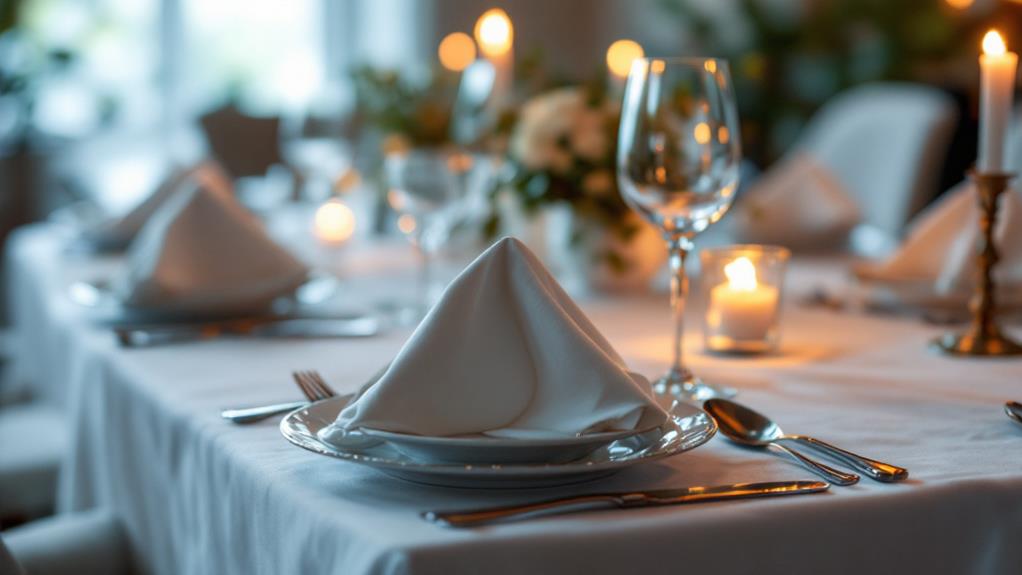
In formal dining settings, proper etiquette with utensils and cutlery becomes crucial. You'll encounter elaborate formal table settings with multiple pieces of silverware arranged in a specific order. It is imperative to know which utensil to use for each course and how to handle them correctly.
Start from the outside and work your way in as the meal progresses. For example, use the outermost fork for the salad course, then move inward for subsequent courses. When you're not using utensils, rest them on your plate in the appropriate position to signal whether you're finished or taking a break.
Proper napkin etiquette is equally important. Place it on your lap when seated and use it to dab your mouth as needed. If you need to leave the table temporarily, loosely fold it and place it to the left of your plate.
To create a vivid image of formal dining, consider these elements:
- Gleaming silver utensils precisely arranged on crisp white linens
- Crystal glasses sparkling under soft chandelier light
- Elaborate centerpieces adorning a painstakingly set table
Care and Maintenance
For the longevity of your utensils and cutlery, proper care and maintenance are essential. To keep your eating implements in top condition, you'll need to adopt proper storage techniques and regular cleaning methods.
Store your utensils and cutlery in a clean, dry place to prevent rust and tarnish. Use drawer dividers or specialized storage containers to keep different types of implements separated and protected from scratches. For silver cutlery, consider anti-tarnish cloth bags or strips to slow oxidation.
When it comes to cleaning, hand-wash your utensils and cutlery immediately after use with warm, soapy water. Avoid leaving them soaking for extended periods, as this can damage handles and encourage rust. For stubborn stains, use a mixture of baking soda and water. Dry your implements thoroughly with a soft cloth to prevent water spots.
For dishwasher-safe items, place them in the cutlery basket with handles facing down. Don't overload the basket, as this can lead to scratches. Remove your utensils and cutlery promptly after the cycle ends and dry them by hand to prevent water spots and potential rusting.
Modern Trends and Innovations
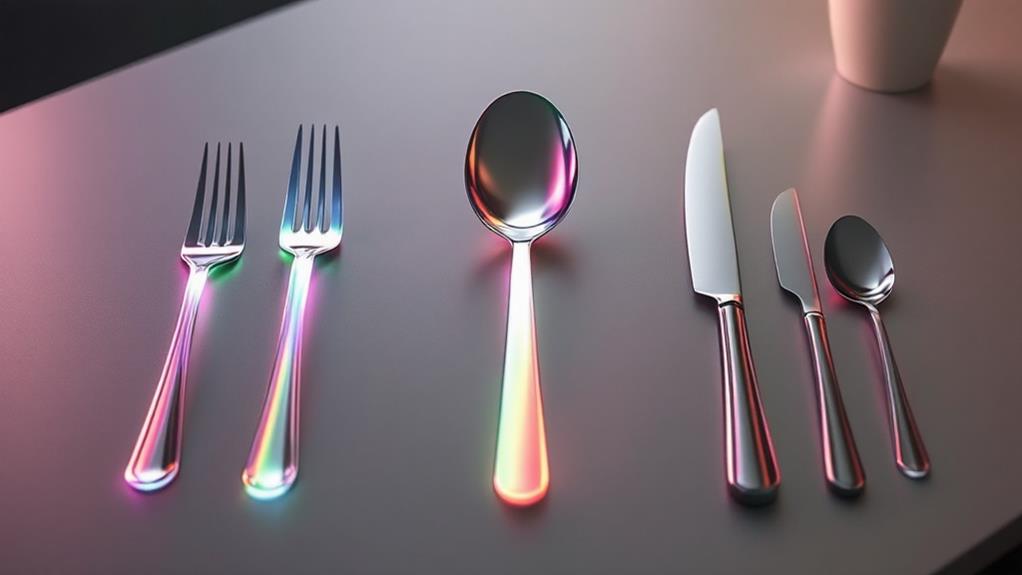
While proper care keeps your utensils and cutlery in top shape, the industry isn't standing still. Modern trends and innovations are revolutionizing the way we think about dining tools. You'll find an increasing focus on sustainable materials, with manufacturers using bamboo, recycled plastics, and even biodegradable compounds to create eco-friendly options. These alternatives not only reduce environmental impact but also offer unique aesthetics for your table setting.
Ergonomic designs are another major trend, with utensils and cutlery now shaped to fit comfortably in your hand, reducing strain during prolonged use. You'll notice subtle curves, textured grips, and balanced weight distribution in newer products. Smart utensils are also emerging, incorporating technology to track eating habits or alert you to allergens in your food.
Some innovative designs you might encounter include:
- Color-changing spoons that detect food temperature
- Foldable utensils for easy storage and portability
- Multi-functional tools that combine multiple utensils into one
As the line between utensils and cutlery continues to blur, these innovations are creating exciting new possibilities for how we interact with our food and enhance our dining experiences.

